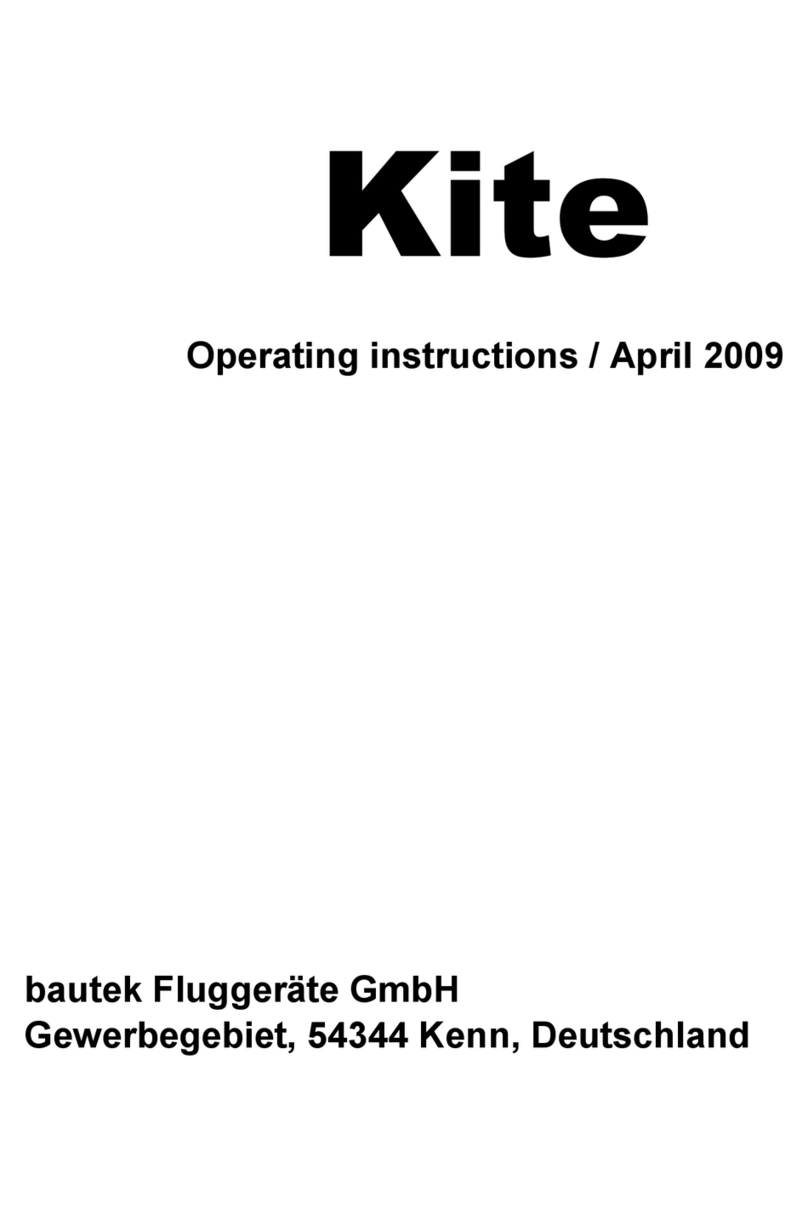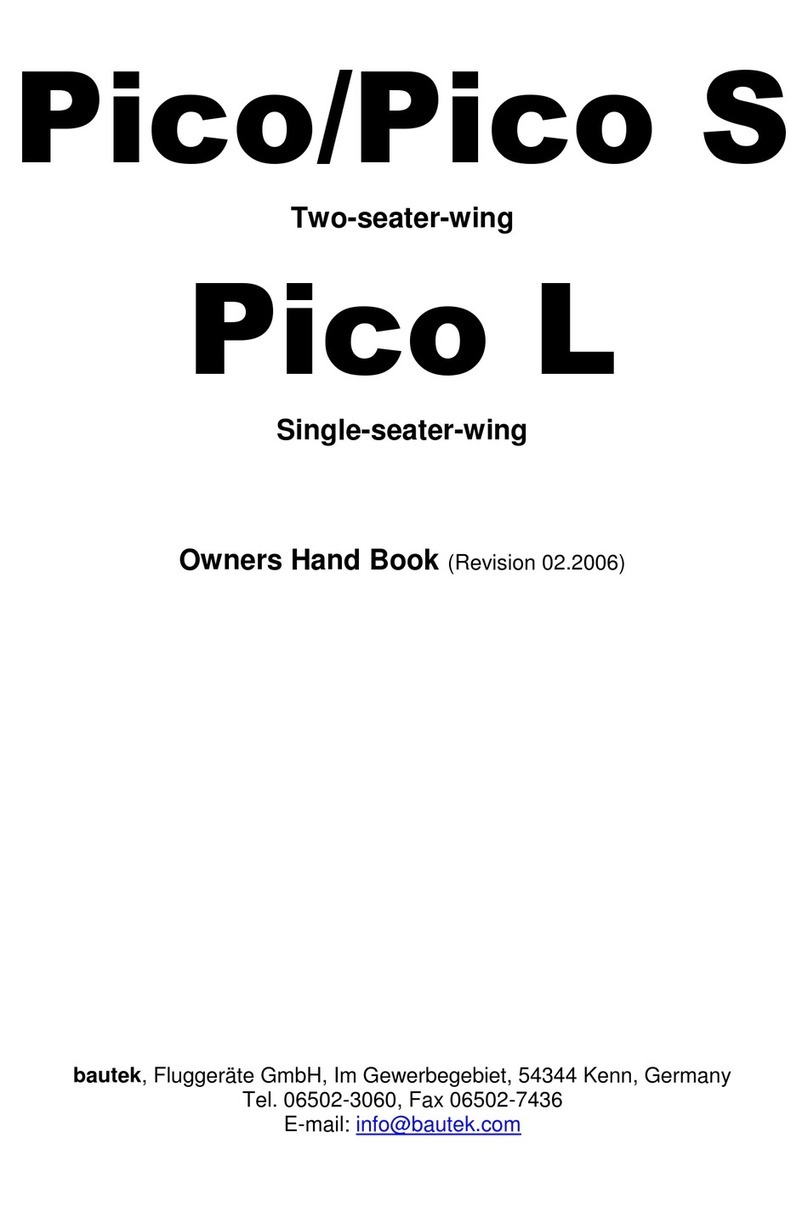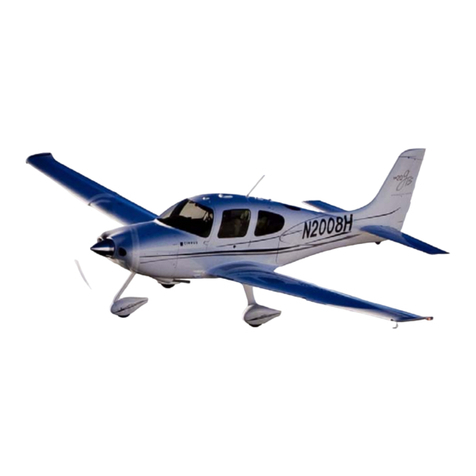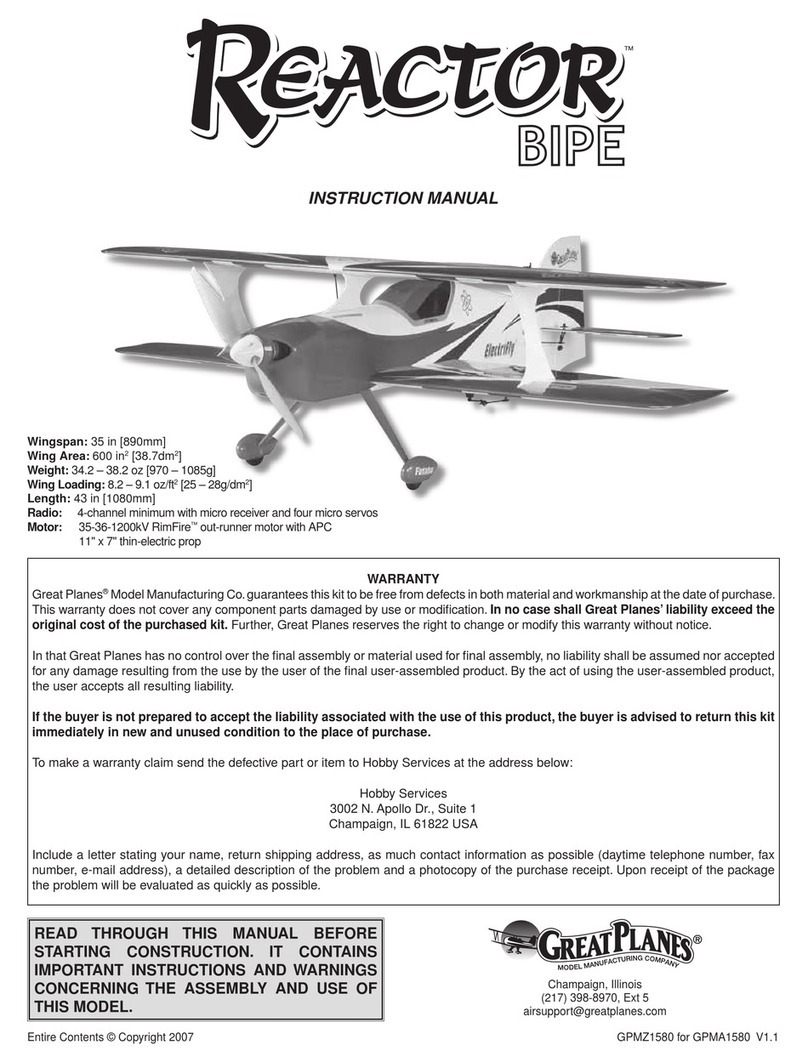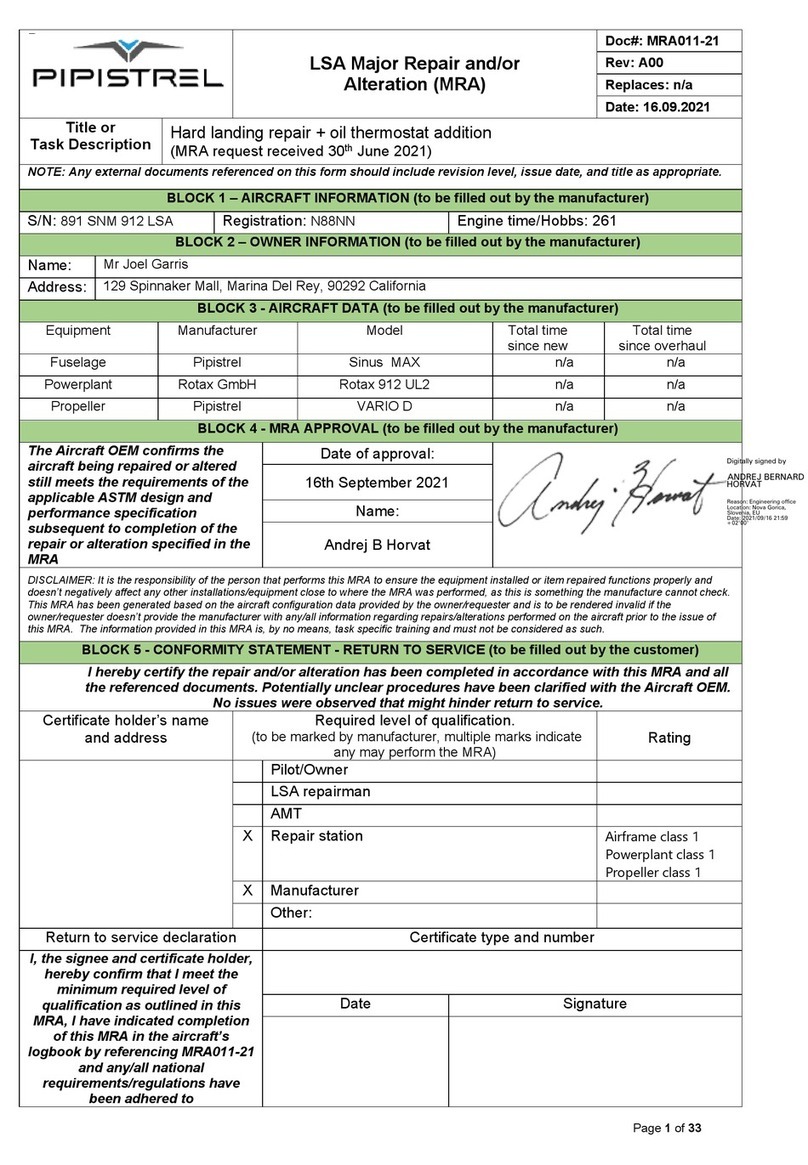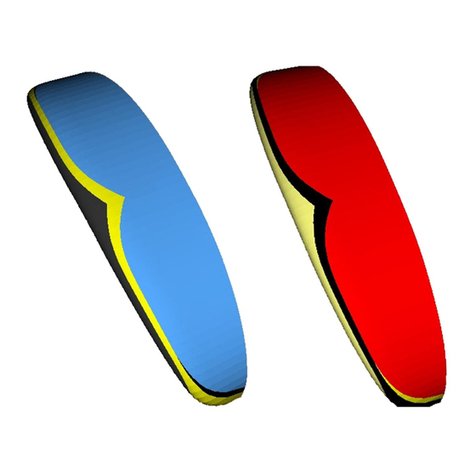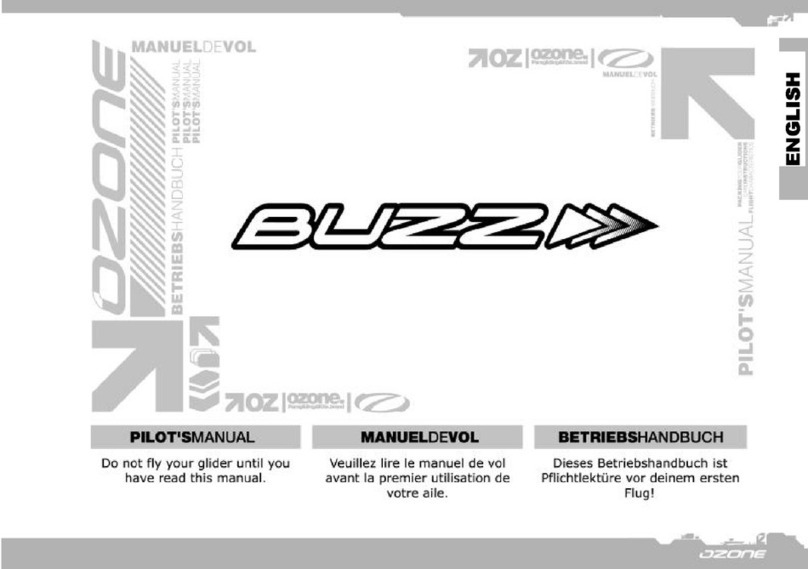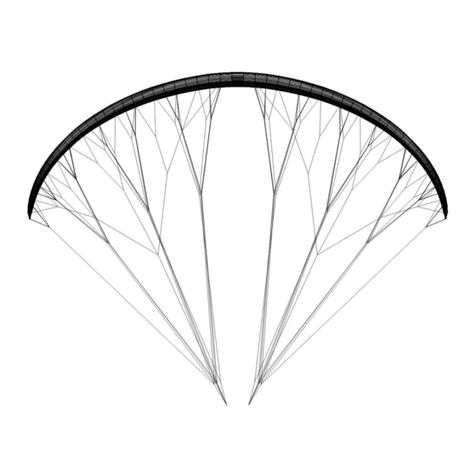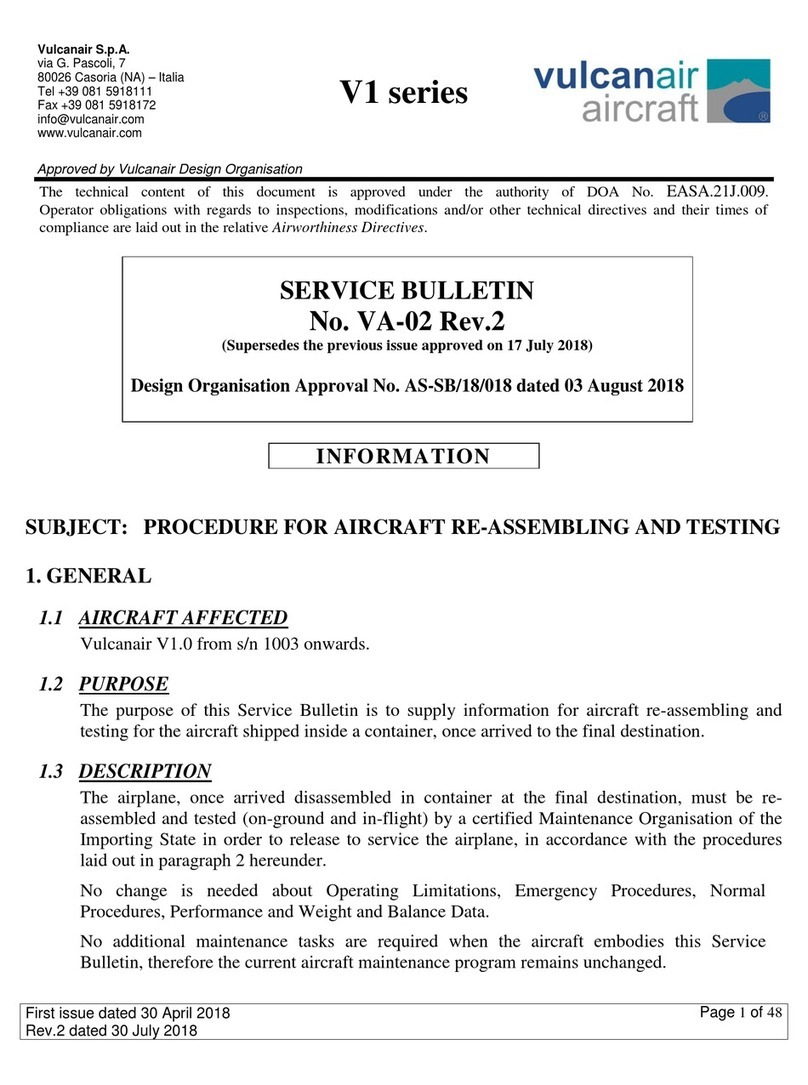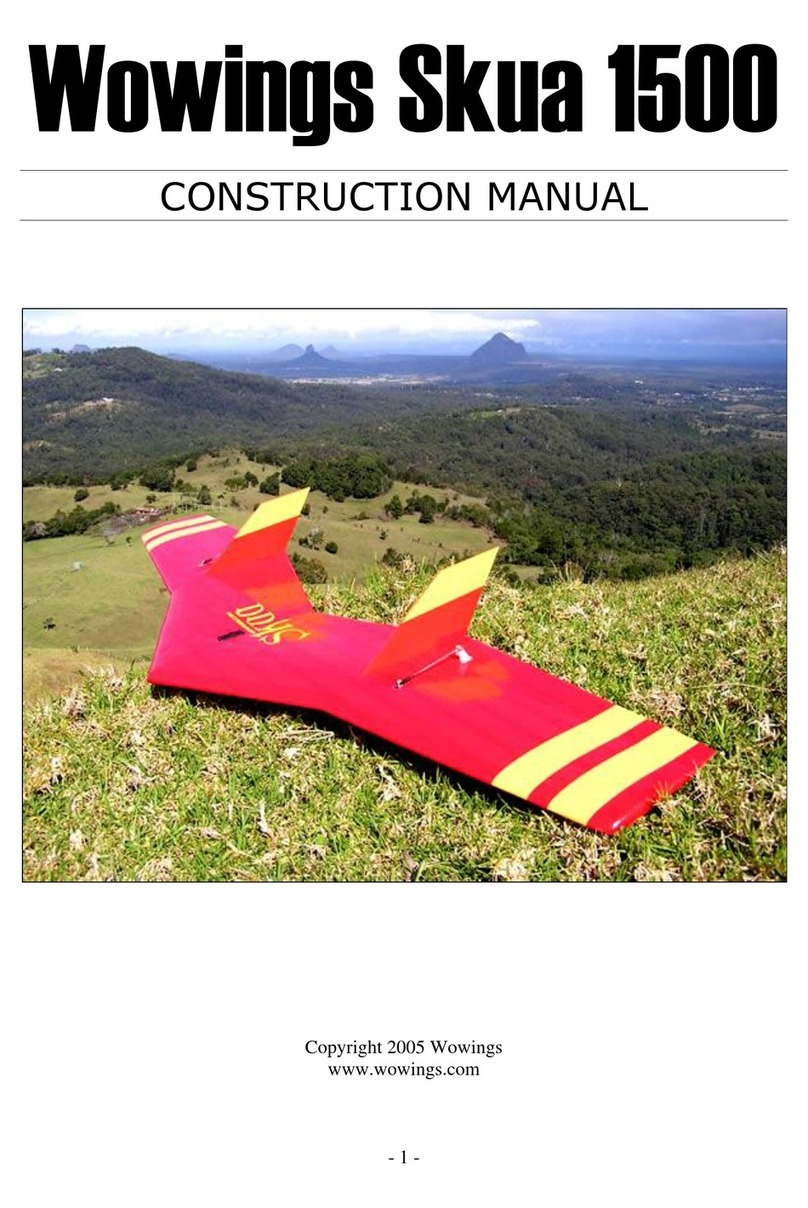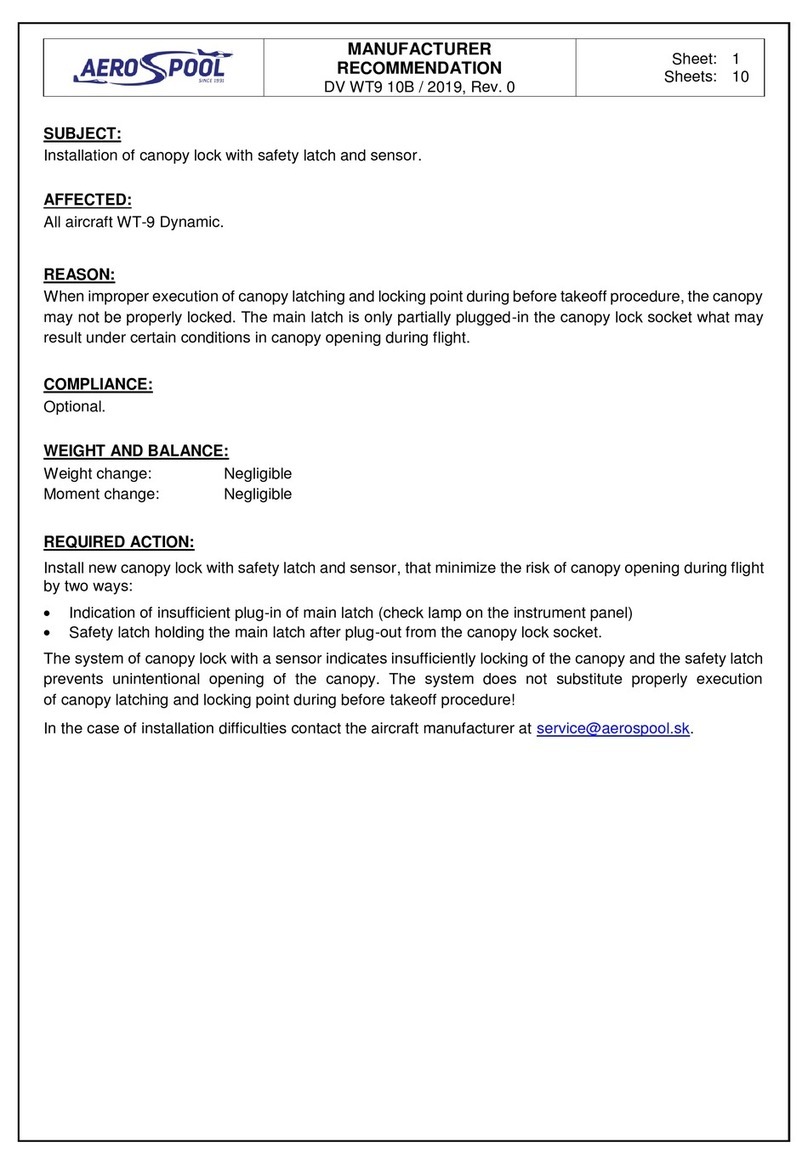bautek Fluggeräte FIZZ User manual

Bautek:
FIZZ
Manual

Bautek :
FIZZ
Owner Manual March 2012
Translation by Konrad Kurp for:
Bautek Fluggreraete Gmbh
Gwerbegebiet, 54344 Kenn, Germany

Table of contents page 1
General Introduction 2
Package contents 3
Set-up from short-pack 3
Leading edge assembly 4
Sail spreading and top battens 5
Spreader bar tensioning 6
Folding tip battens and sail end winglets 7
Bottom battens and swivel tips 8
Nosecone 9
Pre-flight check and start 10
Flight 11
Landing 12
Towing 12
General information 12
Optimum trim 13
Trim: center of gravity and straight flight 13
Break down 14
Maintenance and repair instructions 15
Storage and care 15
Technical data 16
Inspection regulations and protocol 17-23
Specifications _

Fizz Manual [as of 27. March 2012]
General Information
The “Fizz” evolved out of a two year development for a new, light, topless,
high performance glider, which produced after a year a flight ready prototype;
but the weight did not satisfy the high expectations. Therefore a change in
concept was made, before the extensive flight tests were started.
Most pilots, especially longtime and experienced ones, today prefer light,
uncomplicated, but high performance and affordable gliders. The heavy,
topless, high-performance, competition gliders are too demanding to fly and
take the fun out of hang glider flying!
For this reason we developed five years ago the kingposted high performance
“Kite”, which excites many pilots by it’s easy handling and very good
thermaling characteristics today and will do so in the future.
The planned topless was to become a top class glider with kingpost, that sets
new standards in faster glide mode and in X-country flying.
The engine of any hang-glider is the sail. With best sail fabrics the cut for a flat
wing profile was fitted to the flexibility of the leading edge tubes and the sail
battens. In frame and cables we can trust our safe and tested components.
Everything is light and simple to inspect; damage can be repaired
economically.

At the end of a development each glider has a personality, representing
launch-, flight- and landing-characteristics, which are marked by the goal and
capabilities of the designer. With the “Fizz” our top model became reality! We
are convinced, the “Fizz” matches exactly the expectations of the demanding
recreational- and X-country pilot.
Best thermaling and climbing characteristics
Very good glide ratio in wind penetration or fast
flight
Easy launch- and landing characteristics
Safety tested for DHV-airworthiness requirements
Bautek maintenance and repair service
The “Fizz”:
Full Mylar sail of high quality ODL 04/06 (Technora Black)
90% double surface sail
Thin wing profile with 24 top and 6 bottom battens
Narrow wing projection of 152 sft.
VG extended travel with a 24to1 advantage, for easy operation
Radial wingtips with winglets
Spring loaded side wires
Optional profiled Alu-Speedbar with split wheels
Thanks to many clever construction details the set up and break down of this
glider is exemplary simple, and without effort.
We wish you many beautiful flights and always “happy landings”!

Delivery package:
1 Batten plan; 1 Batten-quiver; 3 Padding [kingpost, keel center and end]; 2
yellow Velcro ties; 1 red Velcro tie; 2 Batten plugs front and rear; 2 Wing tip
bags; 1 Cover bag.
Before the first time set-up, it is necessary to read this manual
thoroughly. For additional questions or when uncertain the
manufacturer should be consulted.
The enclosed “Air sport equipment certificate” is part of this manual.
Assembly from the short pack of 13.5 ft [4.15 m]
(Combination cover bag long/short)
Lay down the short pack with the control bar area pointing up. Open the
zipper and put the batten bundle [quiver] and both rear leading edge [wing
tubes] to the side. If you are flying with non-split wheels, slide these on the
speed bar now, before mounting it.
The bow of the speed bar is pointing up, when assembling. Alternatively the
use of a profiled bautek- Alu-speedbar [with or without wheels] is an option.
Attach the speed bar right and left with the push-pins at the control bar
corners.
Now turn the wing over so it lies on the control bar and open the Velcro ties.
Unfold the rear sail-halves to the rear and the swivel-tip of the right and left
outside [= rear] leading edge tube towards the front in the direction of the
keel.

Push the rear sections of the leading edge tubes from the rear into the sail. Let
the swivel tip exit the double sail at the zipper opening and push the tube into
the front leading edge tube with the swivel tip cable pointing up. The swivel
tip will swing to the rear. Press both snaps in and see that both snap out again
through the holes in the front tube.

Then pull the wide, black, inside loop at the end of the sail leading edge over
the end-cap of the rear leading-edge tube. There is an auxiliary loop, which
helps to do this. Pay attention to the proper seating of the loop webbing in the
grove of the plastic end-cap. Close the Velcro loop inside the sail to keep the
black loop from moving out of its grove during transport.
Spreading the sail and inserting the top battens:
Stand the glider on the control bar and raise the kingpost.
Spread the wings in steps, since the spreader bar has limited float.
In strong winds keep the glider flat on the ground for the next steps.
Push the top battens 1-10, starting at the center with Batten 1, into their sail
pockets and secure them with the spring-loaded end plug, by pushing the plug
forward against the spring and releasing the flat tang into the open space in
the trailing edge seam of the sail.

Red batten numbers = left side, green batten numbers = right side, looking in
flight direction. [Portside and Starboard for the mariners] The batten quiver
has separate pockets for the right and left wing. After the top battens are
inserted, you can stand the glider up, if not done earlier, and tension it.
Before tensioning the glider, standing on the control bar, the wings should be
spread as far as possible. Out of the keel-pocket leads a tensioning line to an
elongated hole in the keel tube. Pull the spreader bar with this line to the rear
and hang the steel ring in the notch of the tension line receptacle.
Then the steel ring of the rear upper rigging placed in the same notch. Check if
the snap behind both rings is out and secures them.

In the front the two nose wires of the lower rigging are combined with a small
screw closed triangle. Hang the triangle into the receptacle under the nose
plate and again confirm that the snap secures it.
After this attach the snap hook of the spreader-bar safety cable from below =
upwards into the tensioning line eye at the spreader bar; the zipper of the
double sail is closed after this.

Folding tip battens tensioning; sail end caps = winglets attachment:
The folding mechanism of the tip battens allows their tensioning with ease.
Tension the tip batten always after the spreader bar is tensioned. With de-
tensioned mainframe [=spreader bar] the tip battens carry substantial higher
loads! For tensioning unfold the short end of the batten tube in the direction
of the end of the keel and insert its end plug into the web loop at the rear sail
corner. Now with the open hand [Warning: danger of pinching] inside the
double sail and the other hand at the sail corner, push the hinge of the batten
past its balance point in the direction of the end of the keel.
Fit the two sail end caps [winglets] outside, exactly at the front of the sail and
close the Velcro at the edge of the upper sail first and then the one at the edge
of the lower sail.

Inserting lower sail battens and folding out the Swivel-tips:
Push the straight battens into their pockets in the lower sail; they are not
specifically marked, but clearly of different length; the elongated holes in the
lower sail mark their pockets. Insert them fully and secure them against the
rear seam.
The swivel tips are now folded out and automatically secured in their rear
pocket and the closure of the zipper.

Nose plate cover:
The center battens rest each on a rivet case in the upper nose plate. In the
leading edge right and left in the nose plate area are two short zippers, which
prevent folding of the leading edge in the cover / transport bag. Before you
place the nose plate cover as the last step of the set-up, take a look through the
opening of the upper sail at the nose plate area; make sure all parts are
operational. Close the two zippers in the leading edge and press the Velcro
strips of the cover in the proper position at the upper and lower sail on.
The glider is now flight-ready assembled.

Pre-flight check:
Make it a habit, to do a careful pre-flight check before each start.
Functioning equipment and proper judgment of conditions and the
weather reduce the risk in hang gliding significantly.
1. Check from the nose plate the even bend of both leading edge tubes,
the symmetrical assembly of the glider and the “out” position of safety
snap for the nose wires.
2. Check for easy operation of the VG pulley system and proper
functioning of the VG jam cleat.
3. Base tube installed correctly and no cables kinked and tangs or eyes
twisted?
4. Down tubes straight? Keel tube undamaged at control bar apex?
5. Check all lower rig cables, especially at eyes and press fittings.
6. Lift the glider at the rear end of the keel and check with tensioned VG
for symmetry of the glider, the swivel tips right and left and installation
of the straight battens and their secure seat in the double sail seam.
7. Tensioning line/cable ring seated correct in its seat?
8. Is the keel pocket screwed securely to the keel tube?
9. Are both pilot Hang strap and Safety strap correctly fastened and
undamaged?
Periodically and after a crash inspect in addition:
All tubes for dents and bends as described in the maintenance and
repair protocol.
Upper and lower rigging right and left and the lines and cables inside
the double sail as well as the swivel tip cables.
Batten curves according to the batten chart.

Start:
Always make a hang check before the start or always get in your harness after
it is hooked to the glider and the karabiner is locked. One standard routine
needs to be adopted. A hook-in check is essential immediately before any
start.
The “Fizz” is neutral on the shoulders and easy to guide on launch. The
integral spring system keeps the side wires tensioned, even when the VG is
off; so there is no problem to set proper attitudes and balance for the start.
Pilots, who like “tight” side wires for launching, can do so with ca. 3 ft pulled
out on the VG. Start with a slow jog and accelerate continuously till lift-off.
Close your harness after you are a safe distance from the ground and the
glider flies self-stabilizing.
Flight:
The Fizz has a variable geometry = nose angle [VG], with which the sail
tension can be increased in flight. With loose VG the wing has more twist, is
neutral in turns and easy to handle. For the first flight half tensioned VG is
recommended to avoid over controlling. Even with full tensioned VG can
the Fizz be controlled around the vertical axle; in this configuration the
wing has little twist and its best glide ratio. The Fizz should be steered with
short control impulses, especially at higher speeds under tow, e.g. winch- or
UL aero-tow. Airstream separation [stall] occurs late with loose VG setting and
is easily controlled; after a short dip of the wing the airstream reattaches right
away. With full tensioned VG the stall is more sudden and the wing dips more
pronounced. In very slow turning mode, with tensioned VG the Fizz can be
made to spin, by weight transfer to the rear [“pushing out”]. To exit a spin
bring your weight forward [“pull in”] first then steer against the turn to
the outside of it. [Roll input is after pitch input] For fast altitude loss, e.g. in
“cloud suck”, pull in the base tube and put your weight in one corner. In steep
spirals a lot of altitude is destroyed this way. To exit such a maneuver, center
your weight and level out gradually.
Landing:
Landing starts at altitude with repeated checks of the wind direction. Only
after you are sure of the wind direction, should one decide on the approach
and then stick to it.

The Fizz is easy to land; but an exact landing pattern is important. Too much
altitude is hard to get rid of. Fly the final approach in a straight glide with
some extra speed against the wind and let the glider lose its energy in ground
effect. Change hand position when the glider flies level and at trim speed.
Keep your legs bent and behind you till flair time; arch your back. Your
upper body is thus closer to the down tubes and you have a longer way for the
flair. The Fizz glides long in ground effect and stalls soft and easy, with 1/3 VG
harder, but more definitive. The nose comes up by itself during the flair,
increases angle of attack and drag, and stand up landings are already possible
in a light head wind.
Towing:
The Fizz is licensed for winch- and UL- tow. Requirements for this per DHV
are:
A certified hand glider tow winch
Tow training of the pilot
Training of the winch operator and the UL-Pilot
A certified tow hook up / latch system
For the UL-tow the VG should be ca. 70-100 % tensioned. Then the glider has
less control bar pressure, but is still very controllable. Give at disturbances
only short, strong steering impulses with the hip [body center of gravity]
and keep the tow latch in the middle of the base tube. Weight shift into a
corner and waiting for a course correction leads as a rule to PIO [pilot induced
oscillations] of the glider. Do not support yourself on the base tube. Tip: Pull in
on the base tube with open hands.
General information and limitations:
The Fizz is in Germany type tested by the DHV and certified as a class 3 model.
The Fizz is licensed to be flown only:
by pilots with a correspondent license and training
solo
with an angle of +30deg to -30deg to the horizon
with a roll angle up to 60deg, and
with a top speed of max. 56 mph
The Fizz is not to be used for aerobatics. It can be motorized with
different motor systems [take notice of the license].

In Germany hang gliders can only be started and landed I approved/official
fields. Is after a X-country flight an out landing is necessary, a timely search
for a suitable landing field is advisable. If damage is caused in the landing,
owner and personal liability insurance company are to be informed.
Maximum flight enjoyment through optimal trim:
The sails of modern High Performance [HP] gliders are more tensioned and
therefore more sensitive to their configuration = trim. Sail fabric and sail-
construction tolerances are with special measuring devices taken into account
and individually corrected for. Despite these in depth measuring techniques it
might be necessary after some time, to correct the basic trim.
Test the glider always in light thermal conditions, because changes in flight
characteristics are easier detected in moving air. It is certainly not the case
that more tension also brings about better performance. The sail tension in
the direction of the wingspan can be changed with the position of the leading
edge end pieces and the folding batten length. The end pieces are in standard
production screwed through the middle hole to the tube end.
In case you make any changes, we recommend, marking first the old
position, so that in case the change is unsuccessful, the original position
can be found again.
Center of gravity:
The Fizz should fly ca. 18.5-22 mph [30-35kmh] with hands of = at trim. By
repositioning the kingpost in its base [case-nut, for six point insert] the center
of gravity can be adjusted. Moving forward = nose heavy = faster, to the rear =
tail heavy = slower!
Straight flight:
Glider draws slightly to the right: left end piece higher, i.e. screwed through
the lower hole, or/and reducing right folding batten length by ca. two
revolutions.
Glider draws slightly to the left: right end piece higher, i.e. screw in lower
hole, or/and batten length on left side reduced by ca. 2 revolutions.
If these changes are not sufficient, can on the better carrying side the bend of
batten no. 10 at the high point be reduced by ca. 3/16 to 3/8 inch [5-10mm];
or on other side be increased.

If the leading edge end piece tension is increased on one side, then the folding
batten of the same side has to be lengthened by ca. 5/32 inch [4mm]. The
folding batten has a threaded adjustment at the front, turning the nut changes
the length of the batten. Check the curve of the battens from time to time.
Call us, if flight characteristics and performance of your glider do not
meet your expectations and you are not totally enthusiastic about your
wing. We love to advise you in finding the optimal adjustment / trim for
your weight.
Warnings:
Open zippers and / or no nose cone result in a dangerous flying tendency with
negative bar pressures, especially in fast flight. In this case fly rather slow to
the closest landing area!
Raindrops on the leading edge disturb the airflow! In this case fly faster, to
blow them partially off, do not fly tight turns and anticipate an early and
sudden stall at the landing. Tip: Apply a dishwashing soap to the leading edge
before the start. This prevents for a time the forming of droplets and assures
normal flight characteristics even in rain!
Glider breakdown:
The breakdown of the glider is done in reverse order of the assembly, with
attention to the following details:
Remove the nose cone and open both zippers at the leading edge, before you
place the glider down on the nose. Open the zippers of the four swivel tips and
swing the swivel tips outward.
Loosen the underside of the sail end caps [winglets] first with a finger, before
removing the caps sideways from the Velcro on the upper sail edge.
Pull the lower battens and detention the folding battens. Set the glider on the
end of the keel and detach the spreader bar safety cable and the triangle of the
nose wires. This triangle can be hooked into the snap hook of the spreader bar
safety cable, so it is close at hand at the next assembly.
Pull the upper battens 10 –1 right and left out of the sail and fold the wing in
increments together. Roll up each side of the sail and secure each side,
separately at the middle swivel tip with a flour yellow Velcro tie. The red tie is
longer and is placed in front of the control frame apex. Each rolled up sail end
is put together with the folded swivel tip in the long cover bag.

Close the ties loosely to avoid permanent folds. Pull the cover bag over the
standing glider and close it’s zipper from the front up to the control frame
apex. Now turn the glider over, lay it on it’s back and remove the speed bar.
Put the protective pouch, sown to the cover bag, over both down tube ends.
Lay the batten bag and the sail end caps in the rear of the cover bag. Close the
zipper all the way.
Maintenance and Repair protocol:
For car transport a special support system or a ladder are advantageous. Do
not roll the sail to tight at the Mylar insert. The Velcro ties should also not be
too tight, to avoid folds in the leading edge. A wet glider needs to be spread
out for drying after transport, to prevent mildew spots in the sail. Undo the
Velcro ties for this! Carefully inspect the glider after a crash!
In the lower sail at the keel and the swivel tips are zippers, which facilitate a
thorough inspection. After a hard crash the disassembly ob the tubes is
recommended. In an overload situation a tube is first permanently bent and
then breaks subsequently. Therefore bent tubes where already overstressed
and need to be promptly replaced, because the metal structure is damaged.
Call us, if in doubt. Because of repeated set up and break down most cables are
subject to added (ab-) use, especially in the area of the press fittings and eyes;
Check this area regularly!
From time to time the sail battens need to be checked for correct form
according to the batten plan. The length of the leading edge tube end piece is
for each glider individually adjusted. If such a part is replaced, the original
length must be ordered or adjusted to.
Damaged down tubes can be removed by pushing in the snap safety at the top
and unscrewing the M5 Allen bolt at the bottom. All bolt connections without
nylon locknuts are to be secured with Loctite 243. Instructions are on the
Loctite container.
Inspections:
After 60 month the Fizz needs to be inspected by the manufacturer or
self inspected according to the attached inspection protocol. This
inspection is to be repeated and documented every 24 month thereafter.

Storage, maintenance and disposal:
Spray all zippers from time to time with Cockpit spray [silicon spray].
Standard gentle washing soaps will clean the sail. Rinse with clear water.
Spots on the Mylar leading edge, e.g. adhesives from markings can be removed
with acetone. For maintenance of the Mylar upper sail and the leading
edge a plastic deep care solution [automotive shop] can be used. This
keeps the Mylar flexible and protects it better from sunlight [UV-
radiation]. Store the glider in a dry room on wall brackets.
For transport on the car roof support a PVC cover bag over the light
standard bag is recommended. This will protect the sail from rain and
flapping.
For final disposal of the glider cut up the sail with a new box knife and bundle
it. The sail fabric is polyester and goes to a waste disposal site. The aluminum
tubes get disassembled and go with the SS cables and bolts to the metal
recycler.
Technical specifications:
Bautek model: Fizz
[type tested DHV 01-0462-12]
HG class: DHV
3, solo
Sail area: 152
sft [14.1 qm]
Span: 34 ft
[10.41 m]
Nose angle: 130
degr.
Aspect ratio: 7.7
Double surface: 90 %
Length packed-: long
18.7 ft; short 13.5 ft [5.7m, 4.1m]
Battens: 24
top; 6 bottom
Stall speed: ca. 16
mph [25 km/h]
Other bautek Fluggeräte Aircraft manuals
